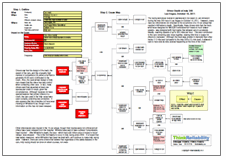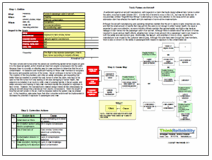Thailand is experiencing an unusually heavy monsoon season, but it’s management of the rains that are being blamed for the most severe flooding to occur in the area in decades. Heavy rains resulting from the monsoon season and high tides are creating serious difficulties for officials in the area, who are having to make hard choices with where to divert water and are essentially “sacrificing” certain towns because there’s nowhere else for the water to go. One of these decisions ended in a gunfight. Tensions are high, and people are busying themselves attempting to protect their homes and towns with hundreds of thousands of sandbags.
 We can examine the issues contributing to the risk to people and property in a Cause Map, or visual root cause analysis. First, we define the problem within a problem outline. In the bottom portion of the outline, we capture the impacts to the country’s goals. More than 200 people have been reported killed as a result of the floods, which are themselves an impact to the environmental goal. If citizens can be considered customers, the decision to “sacrifice” some towns to save others can be considered an impact to the customer service goal. The property goal is impacted by the destruction of towns and the labor goal is impacted by the flood preparations and rescue missions required to protect the population.
We can examine the issues contributing to the risk to people and property in a Cause Map, or visual root cause analysis. First, we define the problem within a problem outline. In the bottom portion of the outline, we capture the impacts to the country’s goals. More than 200 people have been reported killed as a result of the floods, which are themselves an impact to the environmental goal. If citizens can be considered customers, the decision to “sacrifice” some towns to save others can be considered an impact to the customer service goal. The property goal is impacted by the destruction of towns and the labor goal is impacted by the flood preparations and rescue missions required to protect the population.
Beginning with these goals and asking “Why” questions, we can diagram the cause-and-effect relationships that contribute to the impacts discussed above. The decision to “sacrifice” some towns to save others is caused by flooding due to heavy monsoon rains and high tides, and the fact that water had to be directed towards some towns, as there is nowhere else for the water to go. Towns have been built in catchments and areas designed to be reservoirs. Natural waterways have been dammed and diverted. Dams are full because insufficient water was discharged earlier in the season due to a miscalculation of water levels. Canals have been filled in or are blocked with garbage. Insufficient control of development in the area has led to insufficient control of water flow, and lack of areas for water to gather – without endangering towns.
Thailand officials are assisting with sandbags and building new flood barriers and drainage canals. They’re admitting that this issue needs to be repaired. According to the director of the National Disaster Warning Center, “If we don’t have integrated water management, we will face this problem again next year.” Hopefully this is the first step in making changes that ensure loss of life and property is minimized during the annual rainy season.
To view the Outline and Cause Map, please click “Download PDF” above. Or click here to read more



